What Are the Challenges Facing the Electrical Grid in the United States?
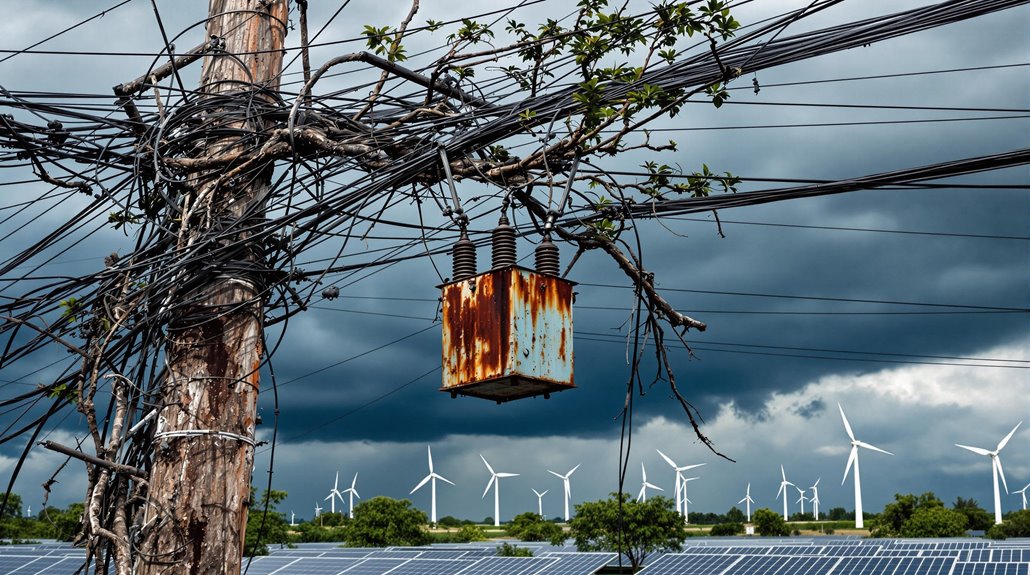
The U.S. electrical grid faces several critical challenges that affect you daily. You'll encounter issues from aging infrastructure struggling to meet growing demand, especially with power-hungry technologies like EVs and data centers. You're also impacted by extreme weather events causing outages, while cybersecurity threats pose national security risks.
The integration of renewable energy sources creates bottlenecks, and utilities must balance modernization costs with affordable rates. Understanding these challenges reveals solutions for a more resilient future.
Growing Demand vs. Aging Infrastructure
While electricity powers nearly every aspect of modern life, America's aging power grid is struggling to keep pace with exponential demand growth. You're witnessing a perfect storm as extreme weather events batter aging infrastructure while power-hungry technologies like data centers and electric vehicles push energy requirements to new heights. The devastating 1965 Northeast Blackout demonstrated how vulnerable interconnected power systems are when a single point of failure triggers cascading outages across multiple regions. The grid's capacity problems are intensifying as you see power plants retiring faster than new ones can replace them.
When utilities try to expand transmission lines and build new energy facilities, they're hitting roadblocks. You'll find that construction timelines stretch for years, and critical equipment shortages are delaying essential grid upgrades. These challenges are creating a widening gap between your growing power needs and the grid's ability to deliver reliable energy, raising concerns about future electricity supply and infrastructure stability.
Weather-Related Vulnerabilities and Grid Resilience
The increasing strain on America's power grid has exposed its vulnerability to extreme weather events. As climate change intensifies weather patterns, power outages are becoming more frequent, particularly when storms and wildfires threaten aging transmission lines.
Yet, there's encouraging news about grid resilience. You'll find that states are actively diversifying their energy generation sources. Texas now produces 40% of its electricity from nuclear, wind, and solar, while Ohio has dramatically expanded its solar capacity. California's hydroelectric capabilities have strengthened following recent rains, demonstrating how varied energy sources can help maintain stability during severe weather.
While weather-related challenges persist, you can see how grid operators are adapting through strategic infrastructure improvements and energy source diversification, making the power system more resilient against extreme weather events. With most grid components averaging 40-50 years old, infrastructure aging remains a critical vulnerability that requires immediate attention.
Renewable Energy Integration Bottlenecks
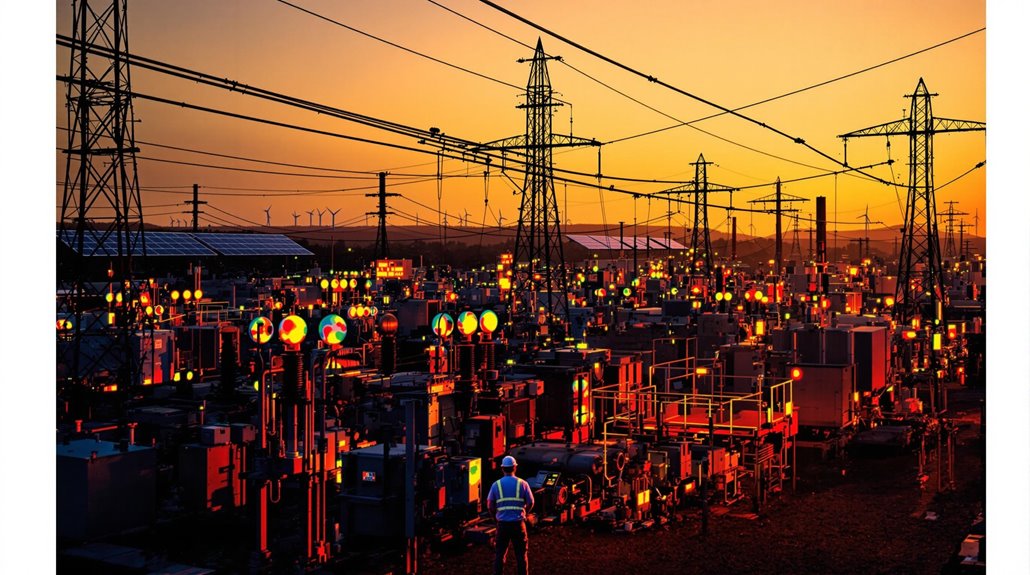
Massive integration bottlenecks pose a critical challenge for America's renewable energy expansion, with over 2,000 gigawatts of clean energy projects stuck in connection queues. You'll find grid operators and regional transmission organizations (RTOs) becoming increasingly overwhelmed by the surge in renewable energy sources seeking grid access.
The Electric Reliability Council and FERC are working to streamline the process by reviewing projects in clusters rather than one by one. While new power lines are essential for expansion, energy storage systems offer a partial solution. You'll see battery storage capacity double in 2024, with Texas and California leading the way. However, these improvements can't fully address the backlog without significant changes to the approval process.
The current delays are seriously hampering America's shift to a cleaner energy future. The integration challenges are particularly complex since the grid must handle both alternating current from power plants and direct current from solar installations.
Energy Storage and Distribution Limitations
Despite recent advances in battery technology, America's power grid faces mounting pressure from novel energy storage and distribution challenges. You'll see the end of flat power demand as data centers expand, summers grow hotter, and electric vehicles multiply. While battery energy storage systems are set to double in 2024, they're primarily concentrated in Texas and California, leaving other regions vulnerable.
The Federal Energy Regulatory Commission has recognized these obstacles and is revamping its regulatory process to address the massive 2,000-gigawatt backlog of clean energy projects. Regional transmission organizations (RTOs) must now manage an increasingly complex electric grid while dealing with weather-related disruptions.
The aging infrastructure struggles to keep pace with new energy storage demands, leading to more frequent outages and highlighting the urgent need for modernization across the distribution network. The implementation of Phasor Measurement Units has become crucial for monitoring grid stability and preventing cascading failures like those seen in the 2003 Northeast Blackout.
Cybersecurity Threats to Grid Operations
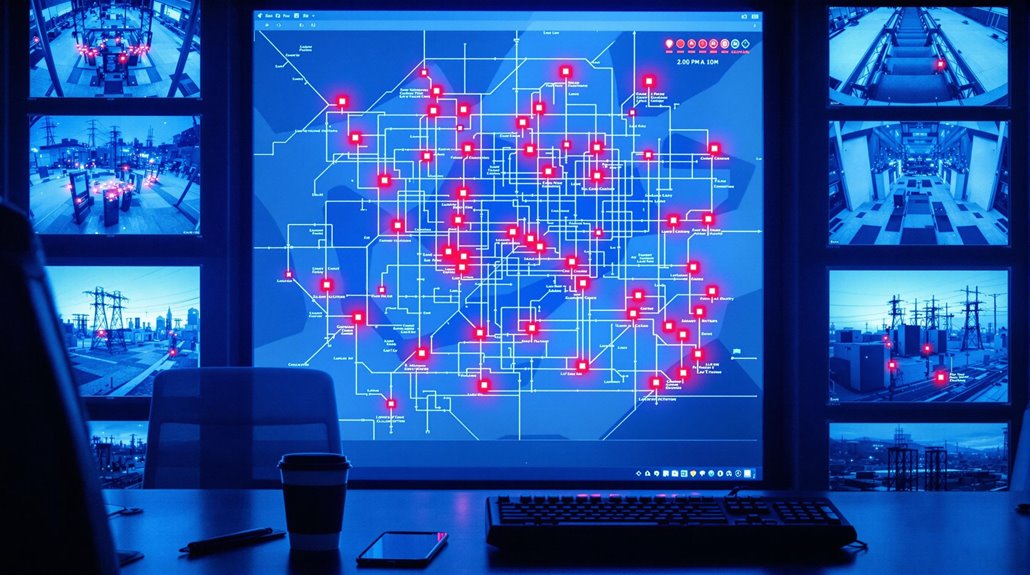
Continuous cyber attacks on America's power grid pose an escalating national security risk, with hacking incidents surging over 200% since 2016. You'll find the United States power grid particularly vulnerable due to aging infrastructure and outdated control systems at power plants across multiple states. The Ukraine grid attack of 2015 serves as a sobering reminder of how cyber threats can disrupt electric power delivery and impact hundreds of thousands of people.
Nation-state actors and cybercriminals target regional transmission organizations (RTOs) and power lines, seeking to exploit weaknesses in the grid's digital infrastructure. To protect against these threats, you'll need to understand how utilities are working to enhance cybersecurity measures, improve system monitoring, and strengthen coordination between government agencies and power providers across interconnected grid networks.
Transmission Line Capacity Constraints
Beyond cybersecurity concerns, the U.S. power grid faces a pressing physical challenge: transmission lines stretched to their operational limits. You'll find that this aging transmission infrastructure can't keep pace with transforming electricity production patterns, particularly as natural gas and renewable sources reshape the power system.
Regional transmission organizations (RTOs) are wrestling with severe congestion issues that drive up your electricity costs and threaten reliability. The U.S. power grid needs over $2 trillion in upgrades by 2050, but you'll see that building new lines isn't simple. Permits take years to secure, and public resistance often blocks construction. While big data helps optimize existing capacity, it's not enough. The challenge of coordinating infrastructure improvements across multiple states and utilities continues to impede progress in modernizing America's transmission network.
Regulatory Hurdles and Policy Fragmentation
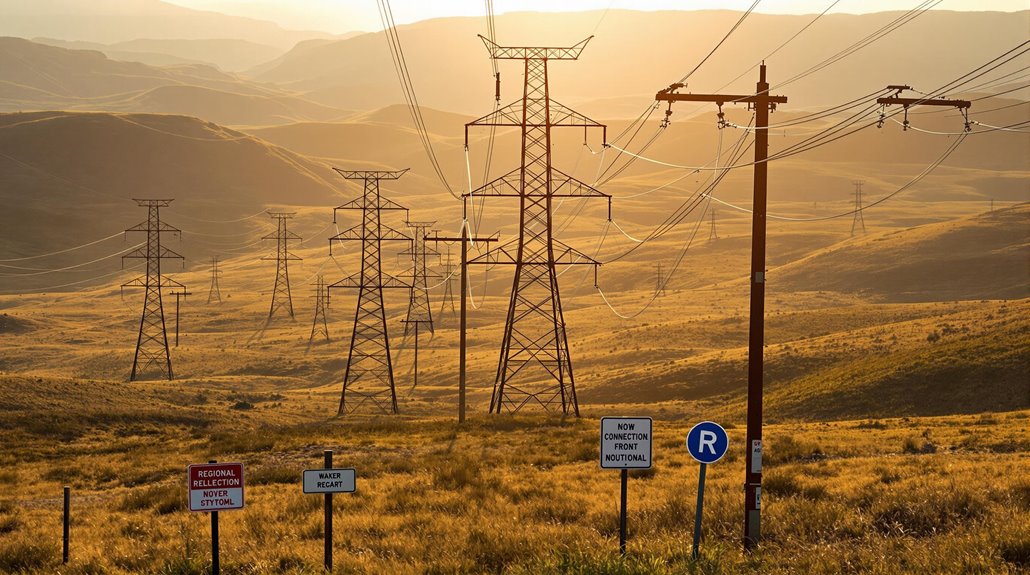
A complex web of regulatory structures divides America's power grid into three major interconnections and twelve distinct planning regions, creating significant coordination challenges. You'll find that this fragmentation makes it difficult to respond effectively when extreme weather events like cold snaps strike multiple regions simultaneously.
The Federal Energy Regulatory Commission (FERC) is working to address these issues through new rulemaking that affects regional transmission organizations (RTOs) from New York to the West Coast. While the Environmental Protection Agency and Grid Strategies support improved inter-regional planning processes, several obstacles remain. The current system lacks harmonized standards and clear cost-allocation mechanisms for cross-border projects. You're seeing the effects of this fragmentation firsthand as climate change increasingly demands a more unified, resilient grid structure that can efficiently transfer power between regions.
Rising Costs of Grid Modernization
While regulatory challenges complicate grid management, the financial burden of modernizing America's electrical infrastructure presents an even more pressing concern. You'll find utility companies struggling to fund the estimated $2 trillion needed by 2050, as reported by the Wall Street Journal. Regional transmission organizations (RTOs) and the Federal Energy Regulatory Commission (FERC) are wrestling with how to distribute these mounting costs across different markets.
The price tag keeps climbing as energy systems require extensive upgrades to maintain production capacity while moving away from fossil fuels. Smart meters, energy storage, and other advanced technologies demand substantial capital investment. With rising material and labor costs straining budgets, you're seeing utilities face tough choices between maintaining grid resilience and keeping electricity rates affordable for consumers.
Environmental Impact and Sustainability Concerns
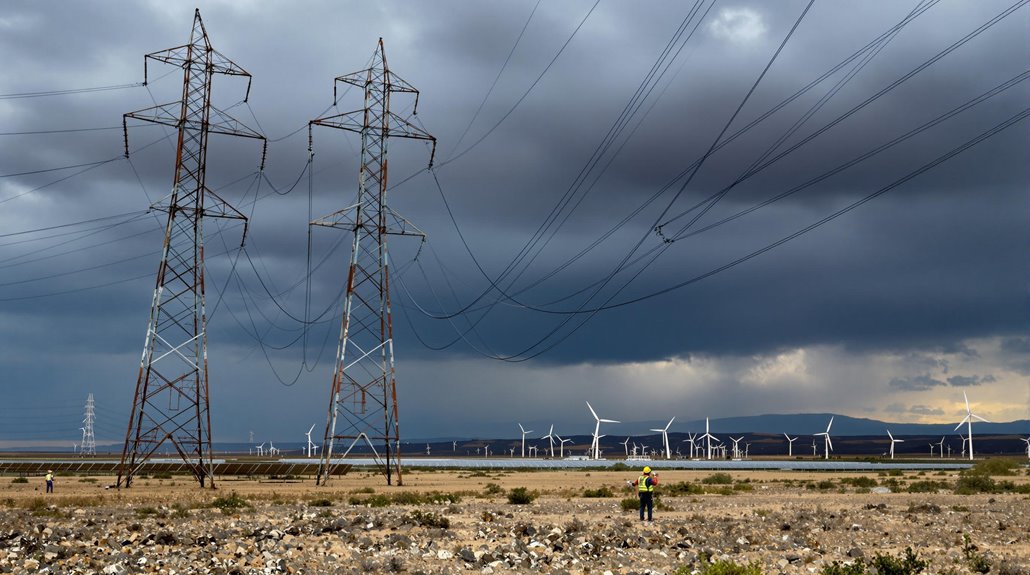
Since climate change continues to intensify, the U.S. power grid faces unparalleled environmental challenges that threaten its stability and resilience. You'll notice how entities like the Energy Regulatory Commission (FERC) and regional transmission organizations (RTOs) are working to address these issues, particularly as clean energy adoption grows. The Reliability Council of Texas (ERCOT) and other balancing authorities struggle to maintain grid stability while integrating variable renewable resources.
As extreme weather events become more frequent, you're seeing increased strain on aging infrastructure and rising energy demand. While the shift to clean energy helps reduce carbon emissions, it's creating new challenges for grid operators. RTOs must carefully balance the intermittent nature of renewable power with reliable service delivery, making sustainability goals harder to achieve without significant grid modernization.




